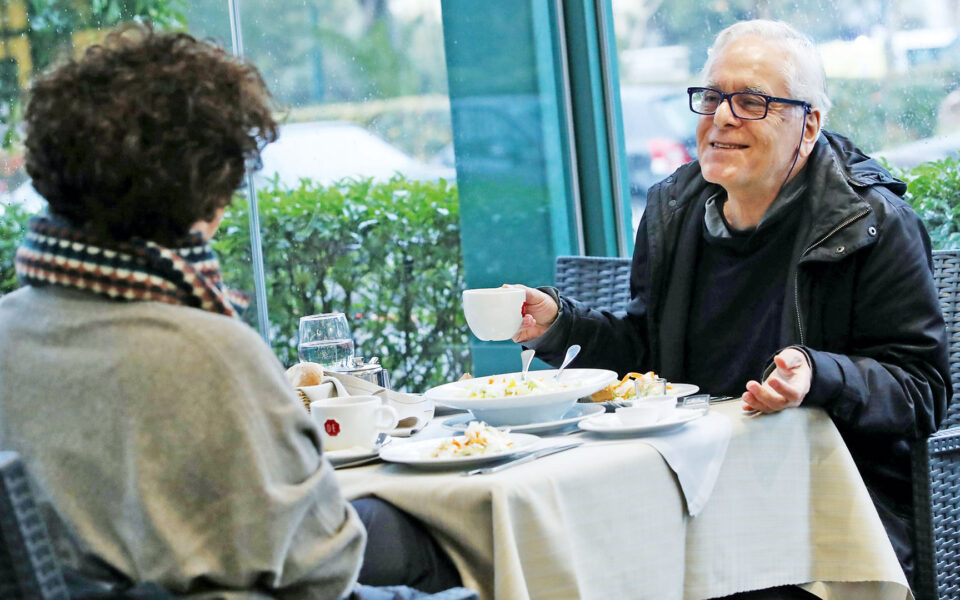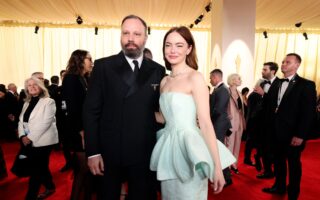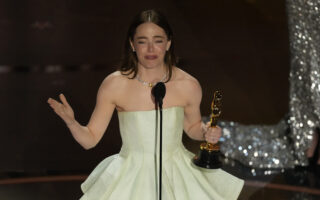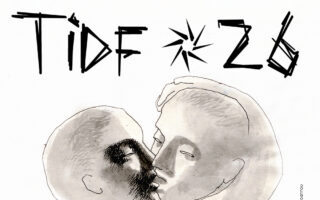‘Poor Things’ editor Yorgos Mavropsaridis constructs a world for the viewer

Yorgos Mavropsaridis celebrated his nomination at this year’s Oscars alongside his two daughters, who joined him on his journey to Los Angeles: 24-year-old Ilektra, a musician, and 27-year-old Penelope, a director. Perhaps this was his greatest joy.
He did not win the Oscar for film editing in Yorgos Lanthimos’ “Poor Things” (the prize went to Jennifer Lame for her work on Christopher Nolan’s “Oppenheimer”), but Mavropsaridis is already one step ahead. He has completed the editing for Lanthimos’ next film, “Kinds of Kindness,” co-written by Efthimis Filippou, featuring three stories with the same actors in different roles and a common character. Filming for the movie, which stars Emma Stone, Willem Dafoe and Jesse Plemons, took place in New Orleans, while the editing was carried out in Athens.
“Another film?” I inquire, attempting to spark the conversation. But even if he did want to work on another film, it would not be possible, as “Yorgos is planning a new one for May,” he responds. “So, it’s like a marriage then?” I comment. “In a way, yes!” he chuckles. The two crossed paths in 2000 in the advertising industry, and since then they’ve been nearly inseparable. Does it bother him that he’s so closely associated with Lanthimos? “Not at all. No nomination or award would be possible without Lanthimos’ vision and collaboration. He’s a very generous director who allows a lot of improvisation. And my work has evolved alongside him.”
To distinguish between them, given that they both share the name Yorgos, he’s known as “Blackfish” among their friends.
14 awards
Mavropsaridis’ personal IMDb page boasts 14 awards and 53 nominations. He began as a Moviola operator, the workhorse of the editing world that remained the standard editing system until the 1960s, requiring manual manipulation to synchronize image with sound.
‘An editor relies solely on the available material. Directors, on the other hand, often contemplate how they would have edited scenes differently’
His approach to editing underwent a dramatic shift when he visited the United States in the early 1990s. There, in San Francisco, he visited Francis Ford Coppola’s studio and encountered an editor employing a new technique. Now, with artificial intelligence, could an automated system potentially label shots and organize them verbally? And is there a risk in all that? “The issue isn’t just about sequencing but the decision-making process and the rationale behind it,” he explains. “Your criteria aren’t solely aesthetic but also involve shaping the viewer’s perception at that moment, creating specific expectations. No matter how much information AI is fed, creativity will always be lacking – the risk which leads us to discover what isn’t immediately evident. Art also encompasses elements that defy logic: Why does the director choose Shot A over Shot B? When altering the sequence of scenes, it involves instinctual decisions based on background, character, and each individual’s mindset.”
“Do you ever feel like you belong to a different generation of film editors?” I ask. “You can’t edit with the mindset of another era,” he responds. “An editor, regardless of age, must adapt and evolve. I’m also addressing a younger audience. An editor improves over time by developing the ‘plasticity’ of the brain. You must break free from your routines. You interact with various directors, each with distinct thinking patterns and demands, necessitating adaptation. Thelma Schoonmaker [Oscar-nominated for Martin Scorsese’s ‘Killers of the Flower Moon’] is 84 years old and still edits with vitality. Michael Kahn, who collaborates with [Steven] Spielberg, is [93]. Editing aids in maintaining a youthful and contemporary mindset.”
“When editing, do you ever feel tempted to say, ‘I’d shoot this scene differently’?” I ask. “Never! Because then you haven’t embraced being an editor, but rather you aspire to be a director,” he asserts. “An editor relies solely on the available material. Directors, on the other hand, often contemplate how they would have edited scenes differently. It’s understandable. When I studied at the London Film School, I viewed cinema more through the lens of an actor. I didn’t delve into directing due to lacking the organizational ability to envision and construct a world with shots. Being a solitary figure, I preferred scriptwriting or editing.”
‘Reversal’
He elaborates on the reversal of scenes and shots, citing an example from “Dogtooth,” about how they decided on the film’s opening scene, setting the stage for viewers to anticipate a narrative where the children – perhaps even the audience themselves – have been exposed to the world in a distinct manner. “It’s not merely about the family or the plot, but also about the existential aspect, the existential dilemma,” he explains. “In ‘The Favorite,’ we implemented a similar reversal. I proposed an alternative approach, which Yorgos embraced. He avoids creating descriptive films, preferring instead to craft essays or dissertations on subjects like love, isolation and absence. Both ‘Dogtooth’ and ‘Poor Things’ revolve around the theme of how individuals perceive the world, offering the perspective of beings capable of challenging societal prejudices and living authentically.”
“I’ve always felt that Lanthimos places actors in experimental conditions and observes their reactions,” I remark.
“Indeed, that’s a hallmark of the ‘Lanthimos universe,’” he confirms. “Actors aren’t instructed to perform a specific way but are encouraged to find their own path within the experiment. There are no rigid instructions. Acting evolves through a series of improvisations. It’s a relationship built on trust between the director and the actor. The director encourages the actor to ‘be’ themselves, guiding rather than dictating how to approach the role. This approach empowers the actor to push boundaries and surpass their limitations. Unlike traditional storytelling, where causality is paramount and one scene leads to the other, we’ve had to deconstruct this notion. Yorgos isn’t concerned with depicting reality; rather, editing aims to provoke questions in the viewer’s mind. The viewer’s reaction holds an element of magic and varies depending on whose mental screen the film projects onto. Lately, I’ve been fascinated by neuroscience and how it influences our perception of the world. Editing is intimately linked to how the brain constructs reality, as the mind harbors predispositions and preconceptions. In this sense, each individual is an experiment.”
“Has your work changed you?” I ask.
“Absolutely. Art has a transformative effect; it provides solace and enlightenment,” he responds. “I believe I was drawn to this profession due to the profound connection between how the mind interprets the world and how editing, employing similar cognitive functions, shapes the cinematic world we perceive. Our brain serves as the ultimate screen, imbuing what we see with meaning and shaping our understanding of the world around us. I edit the way I think.”





